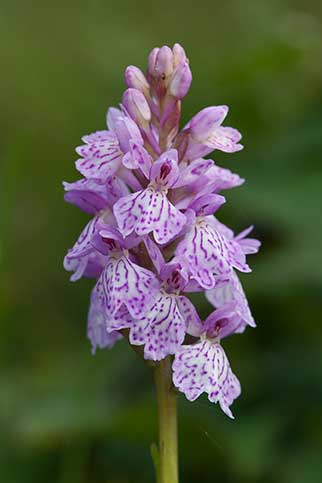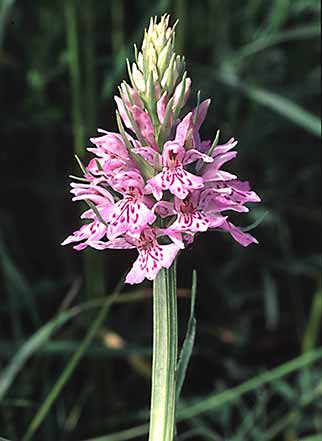Common spotted-orchid and Heath spotted-orchid
(Dactylorhiza fuchsii and Dactylorhiza maculata)
Both common spotted-orchids and heath spotted-orchids occur in the New Forest. They are so similar in appearance that separating the two can sometimes be a challenge, particularly as both are variable in size, flower shape, colour and markings; and hybridisation between the two, and other species, occurs.
Heath spotted-orchid
When: June - July
How many: Common and widespread

Heath spotted-orchids are the commonest of the New Forest orchids. Abundant and widespread throughout much of the area, they favour the acid, heathland-type soils so prevalent in the New Forest. Look out for them particularly in June, which is the main flowering month.
In fertile soil, heath spotted-orchids grow to a height of 45 centimetres (18 inches), although New Forest plants are often considerably shorter, and have a sometimes dense, conical spike of pale pink, blooms clustered around the tip.
Heath spotted-orchid colours range from pale purple, through to white with small pink spots. The lower lip is three-lobed - the side lobes tend to be rounded, and sometimes notched, whilst the triangular central lobe is considerably smaller than that of its outer neighbours.
Narrow, pointed leaves, most prominent in a cluster around the base of the plant, are usually lightly marked with small, distinctive dark blotches.
Common spotted-orchid
When: June - July
How many: Quite common / widespread

The very similar, closely related common spotted-orchid, flowers at around the same time as the heath spotted-orchid, but occurs only in modest numbers, primarily in areas of relatively acid grassland.
Look out for relatively broad leaves at the base of the plant; more extensive, broader spotting; and on the lower lip, a triangular central lobe that is slightly longer than the outer lobes.
References:
Wild Orchids of Hampshire and the Isle of Wight: Martin N. Jenkinson
The Flora of Hampshire: Anne Brewis, Paul Bowman and Francis Rose
Britain's Orchids: David Lang
The Englishman’s Flora: Geoffrey Grigson
More links
Other related links
Search this site

Sadly, 58 animals were killed - 35 ponies, 13 cows, 8 donkeys and 2 sheep, whilst a further 32 were injured - 3 pigs, 9 donkeys, 11 cows and 9 ponies.
(Forty-three accidents occurred in daylight, 15 at twilight and 101 in the dark. Twenty-seven accidents were not reported by the driver involved).
Here's just one horrific example - Three donkeys killed in collision with van at notorious New Forest blackspot (Advertiser and Times)

